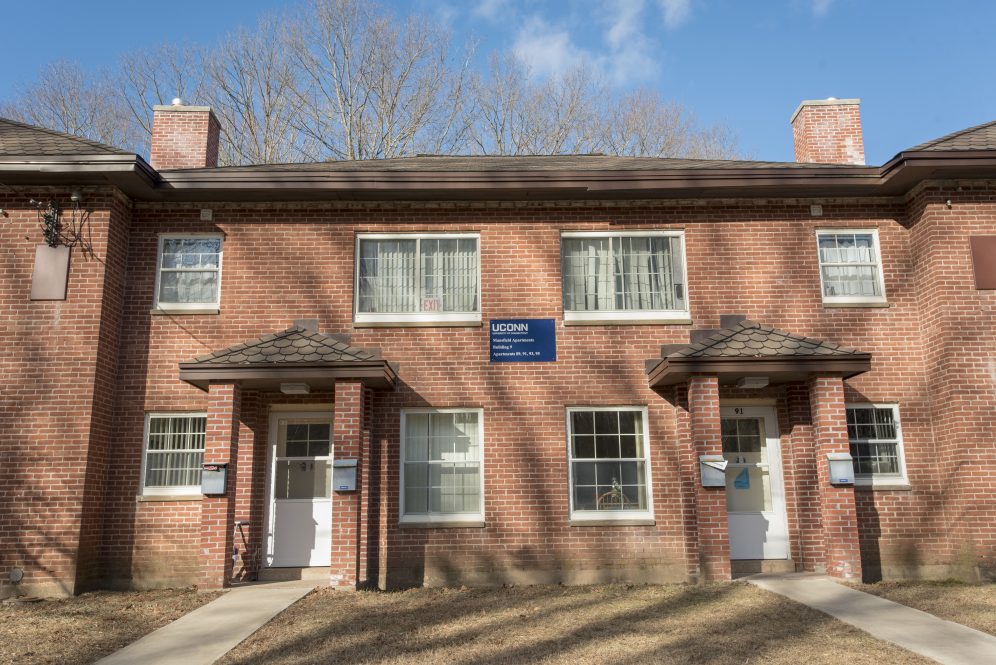A new modern apartment-style student housing complex is envisioned on the site of UConn’s outdated Mansfield Apartments townhouses under a proposal reviewed Wednesday by the Board of Trustees.
The board authorized the University to move forward with the planning and permitting process, in which it will assess ways in which the 16-acre site could be redeveloped to provide more contemporary and updated student apartments.
The proposal has been in the planning stages for several years as part of broader reviews of the University’s current student housing stock and future needs.
The board’s vote Wednesday does not bind the University to the plan, but allows it to work with a design team to determine possibilities that could be built on the Mansfield Apartments site in place of the 1940s-era complex, which has reached the end of its useful life.
UConn houses between 65% to 70% of its undergraduate students on campus each year, one of the highest on-campus residency rates in the nation.
While that creates a vibrant campus and excellent student experience, the average age of UConn residence halls is about 50 years old. Some, like the Mansfield Apartments at about 75 years old, are older and are outdated to a degree that the need for ongoing maintenance and upgrades outweigh their value as a housing option.
UConn Board of Trustees Chairman Dan Toscano said that when he joined the board in 2019, it was clear that envisioning the future of on-campus student housing facilities was one of the most important issues the University would face in coming years.
“It’s a big undertaking and probably overdue, but it’s time for us to really prioritize (it),” Toscano said Wednesday.
The long-planned proposal for the Mansfield Apartments site envisions demolishing the 270-bed, townhouse-style complex and replacing it with denser and more modern 800 to 850 units, which would include contemporary design and amenities more appealing and useful to today’s students.
The complex has been used exclusively as an isolation location during the COVID-19 pandemic, making redevelopment easier now than if it was fully occupied. The University’s intention is to avoid reopening it in its current condition to the general student population.
Creating facilities that are modern, up to date, and will best meet the needs of future students is essential not only to recruitment and retention efforts, but also to ensuring they have a residential environment that supports academic success.
UConn currently has 18 residential communities ranging from pre-war historically noteworthy buildings in the East Campus complex to the Peter J. Werth Residence Tower, which opened in 2016 in the Hilltop area. About two-thirds of the housing stock consists of traditional double or single units.
Student interest in on-campus living has been historically strong, with about 11,000 to 12,000 students in the residence halls at Storrs in an average year.
In a regular year, almost 60 percent of UConn’s on-campus students are freshmen and sophomores, with those younger students most heavily concentrated in the traditional units with roommates.
However, students at all levels have told the University that they prefer suites and apartment-style living because of the independence, community, and convenience they offer.
In addition to providing more modern housing, redeveloping the Mansfield Apartments site also could provide opportunities to increase and enhance community spaces inside and outside of buildings, which complements the University’s academic planning.
As part of its approval on Wednesday, trustees authorized UConn officials to start the CEPA (Connecticut Environmental Policy Act) permitting process for the redevelopment plan and related utility infrastructure and landscape improvements. That process takes about a year.
The COVID-19 pandemic, while forcing UConn to reduce occupancy as a safety and health measure last year, also offered unexpected lessons on ways that student housing can be designed to optimize their physical wellbeing. Suites, apartment-style living and other kinds of housing that limited shared bathrooms provided more ability for students to distance and protect themselves, and also align with their preferences.
The Mansfield Apartments site redevelopment fits with the University’s larger missions to ensure capital projects complement the strategic plan, support student housing renewal, address deferred maintenance needs, and are achieved sustainably, including through net zero-carbon development on land it owns.
The redevelopment proposal would conform to Connecticut High Performance Building regulations and would be registered as an LEED project, with the target of gaining the LEED Gold certification for environmentally conscious construction, design, and operational features.
Additional sustainability measures toward a potential net-zero carbon goal will also be investigated as part of the planning phase.



